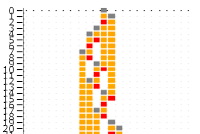-

For years I have been an avid reader of the Science website Naukas. The website is a carrier for online science popularization in Spanish. If you speak the language and love Science, I greatly encourage you to add it to your bookmarks. In particular, I am a big (BIG) fan of Francis’ blog as well as Daniel’s blog that …
Read More -

It is time to conclude this series, but not before making some closing arguments. Resolution It is possible to increase the resolution of the plot by decreasing the length of the step for the different dimensions: latitude, longitude and days in the year. For instance, the values (lat_step = 5, lon_step = 1, year_step …
Read More -

In the previous post of this series: a simple grid consisting of points on the surface of a sphere was built step by step to approximate Earth. the basics of matrix rotations were reviewed to obtain: the tilt of the rotational axis. the changes in the orientation of the tilt relative to the Sun as Earth revolves …
Read More -

It is easy to explain the changing seasons and the variation in the length of day and night time at different latitudes by means of the axial tilt, also known as obliquity (Wikipedia (n.d.a)). Earth currently has a mean tilt of 23.44° (Wikipedia (n.d.a)) between: its rotational axis, the imaginary line that passes …
Read More